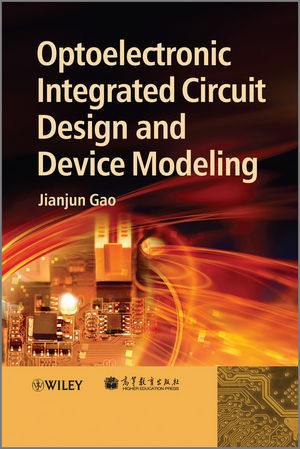
Optoelectronic Integrated Circuit Design and Device Modeling
John Wiley & Sons Inc (Verlag)
978-0-470-82734-5 (ISBN)
- Lieferbar (Termin unbekannt)
- Versandkostenfrei innerhalb Deutschlands
- Auch auf Rechnung
- Verfügbarkeit in der Filiale vor Ort prüfen
- Artikel merken
In Optoelectronic Integrated Circuit Design and Device Modeling, Professor Jianjun Gao introduces the fundamentals and modeling techniques of optoelectronic devices used in high-speed optical transmission systems. Gao covers electronic circuit elements such as FET, HBT, MOSFET, as well as design techniques for advanced optical transmitter and receiver front-end circuits. The book includes an overview of optical communication systems and computer-aided optoelectronic IC design before going over the basic concept of laser diodes. This is followed by modeling and parameter extraction techniques of lasers and photodiodes. Gao covers high-speed electronic semiconductor devices, optical transmitter design, and optical receiver design in the final three chapters.
Addresses a gap within the rapidly growing area of transmitter and receiver modeling in OEICs
Explains diode physics before device modeling, helping readers understand their equivalent circuit models
Provides comprehensive explanations for E/O and O/E conversions done with laser and photodiodes
Covers an extensive range of devices for high-speed applications
Accessible for students new to microwaves
Presentation slides available for instructor use
This book is primarily aimed at practicing engineers, researchers, and post-graduates in the areas of RF, microwaves, IC design, photonics and lasers, and solid state devices. The book is also a strong supplement for senior undergraduates taking courses in RF and microwaves.
Lecture materials for instructors available at www.wiley.com/go/gao
Jianjun Gao is a Professor of information science and technology at East China Normal University in Shanghai. His research interests are characterization, modeling and on-wafer measurement of microwave semiconductor devices, optoelectronics devices and high-speed integrated circuits for radio frequency and optical communication. He has held positions as Researcher at Nanyang Technological University in Singapore, specializing in semiconductor device modeling and on wafer measurement, and as Research Associate at the Institute for High-Frequency and Semiconductor System Technologies, Berlin University of Technology, Germany, where he worked on InP HBT modeling and circuit design for high speed optical communication. Gao has also spend time at the Microelectronics R&D Center of the Chinese Academy of Sciences researching PHTEMT optical modulator drivers. He is currently a member of the editorial board of IEEE Transaction on Microwave Theory and Techniques. Gao holds a M. Eng. degree from Hebei Semiconductor Research Institute and a PhD from Tsinghua University.
Preface. About the Author.
Nomenclature.
1 Introduction.
1.1 Optical Communication System.
1.2 Optoelectronic Integrated Circuit Computer-Aided Design.
1.3 Organization of This Book.
References.
2 Basic Concept of Semiconductor Laser Diodes.
2.1 Introduction.
2.2 Basic Concept.
2.2.1 Atom Energy.
2.2.2 Emission and Absorption.
2.2.3 Population Inversion.
2.3 Structures and Types.
2.3.1 Homojunction and Heterojunction.
2.3.2 Index Guiding and Gain Guiding.
2.3.3 Fabry–Perot Cavity Lasers.
2.3.4 Quantum-Well Lasers.
2.3.5 Distributed Feedback Lasers.
2.3.6 Vertical-Cavity Surface-Emitting Lasers.
2.4 Laser Characteristics.
2.4.1 Single-Mode Rate Equations.
2.4.2 Multimode Rate Equations.
2.4.3 Small-Signal Intensity Modulation.
2.4.4 Small-Signal Frequency Modulation.
2.4.5 Large-Signal Transit Response.
2.4.6 Second Harmonic Distortion.
2.4.7 Relative Intensity Noise.
2.4.8 Measurement Technique.
2.5 Summary.
References.
3 Modeling and Parameter Extraction Techniques of Lasers.
3.1 Introduction.
3.2 Standard Double Heterojunction Semiconductor Lasers.
3.2.1 Large-Signal Model.
3.2.2 Small-Signal Model.
3.2.3 Noise Model.
3.3 Quantum-Well Lasers.
3.3.1 One-Level Equivalent Circuit Model.
3.3.2 Two-Level Equivalent Circuit Model.
3.3.3 Three-Level Equivalent Circuit Model.
3.4 Parameter Extraction Methods.
3.4.1 Direct-Extraction Method.
3.4.2 Semi-Analytical Method.
3.5 Summary.
References.
4 Microwave Modeling Techniques of Photodiodes.
4.1 Introduction.
4.2 Physical Principles.
4.3 Figures of Merit.
4.3.1 Responsivity.
4.3.2 Quantum Efficiency.
4.3.3 Absorption Coefficient.
4.3.4 Dark Current.
4.3.5 Rise Time and Bandwidth.
4.3.6 Noise Currents.
4.4 Microwave Modeling Techniques.
4.4.1 PIN PD.
4.4.2 APD.
4.5 Summary.
References.
5 High-Speed Electronic Semiconductor Devices.
5.1 Overview of Microwave Transistors.
5.2 FET Modeling Technique.
5.2.1 FET Small-Signal Modeling.
5.2.2 FET Large-Signal Modeling.
5.2.3 FET Noise Modeling.
5.3 GaAs/InP HBT Modeling Technique.
5.3.1 GaAs/InP HBT Nonlinear Model.
5.3.2 GaAs/InP HBT Linear Model.
5.3.3 GaAs/InP HBT Noise Model.
5.3.4 Parameter Extraction Methods.
5.4 SiGe HBT Modeling Technique.
5.5 MOSFET Modeling Technique.
5.5.1 MOSFET Small-Signal Model.
5.5.2 MOSFET Noise Model.
5.5.3 Parameter Extraction Methods.
5.6 Summary.
References.
6 Semiconductor Laser and Modulator Driver Circuit Design.
6.1 Basic Concepts.
6.1.1 NRZ and RZ Data.
6.1.2 Optical Modulation.
6.1.3 Optical External Modulator.
6.2 Optoelectronic Integration Technology.
6.2.1 Monolithic Optoelectronic Integrated Circuits.
6.2.2 Hybrid Optoelectronic Integrated Circuits.
6.3 Laser Driver Circuit Design.
6.4 Modulator Driver Circuit Design.
6.4.1 FET-Based Driver Circuit.
6.4.2 Bipolar Transistor-Based Driver Integrated Circuit.
6.4.3 MOSFET-Based Driver Integrated Circuit.
6.5 Distributed Driver Circuit Design.
6.6 Passive Peaking Techniques.
6.6.1 Capacitive Peaking Techniques.
6.6.2 Inductive Peaking Techniques.
6.7 Summary.
References.
7 Optical Receiver Front-End Integrated Circuit Design.
7.1 Basic Concepts of the Optical Receiver.
7.1.1 Signal-to-Noise Ratio.
7.1.2 Bit Error Ratio.
7.1.3 Sensitivity.
7.1.4 Eye Diagram.
7.1.5 Signal Bandwidth.
7.1.6 Dynamic Range.
7.2 Front-End Circuit Design.
7.2.1 Hybrid and Monolithic OEIC.
7.2.2 High-Impedance Front-End.
7.2.3 Transimpedance Front-End.
7.3 Transimpedance Gain and Equivalent Input Noise Current.
7.3.1 S Parameters of a Two-Port Network.
7.3.2 Noise Figure of a Two-Port Network.
7.3.3 Transimpedance Gain.
7.3.4 Equivalent Input Noise Current.
7.3.5 Simulation and Measurement of Transimpedance Gain and Equivalent Input Noise Current.
7.4 Transimpedance Amplifier Circuit Design.
7.4.1 BJT-Based Circuit Design.
7.4.2 HBT-Based Circuit Design.
7.4.3 FET-Based Circuit Design.
7.4.4 MOSFET-Based Circuit Design.
7.4.5 Distributed Circuit Design.
7.5 Passive Peaking Techniques.
7.5.1 Inductive Peaking Techniques.
7.5.2 Capacitive Peaking Techniques.
7.6 Matching Techniques.
7.7 Summary.
References.
Index.
| Erscheint lt. Verlag | 15.4.2011 |
|---|---|
| Verlagsort | New York |
| Sprache | englisch |
| Maße | 173 x 252 mm |
| Gewicht | 689 g |
| Themenwelt | Technik ► Elektrotechnik / Energietechnik |
| ISBN-10 | 0-470-82734-3 / 0470827343 |
| ISBN-13 | 978-0-470-82734-5 / 9780470827345 |
| Zustand | Neuware |
| Haben Sie eine Frage zum Produkt? |
aus dem Bereich


